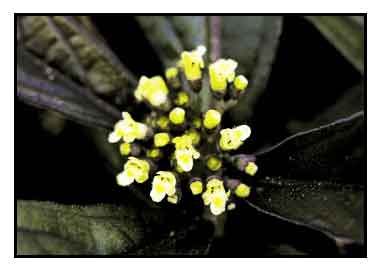 Botany Botany
Huniyan is a small, inconspicuous undershrub growing up to 15 centimeters in height, produced from stout, elongated, woody roots, with hardly any stems. Roots are about as thick as a crowquill with numerous, almost-globular, woody knots. Leaves are simple, obovate-oblong or obovate, up to 13 centimeters long, 6.5 centimeters wide, and pointed at both ends, with entire and irregularly toothed margins. Stalks are very short, 2 to 4 millimeters long. Flowers are greenish-white, 4-parted, and borne on short, terminal inflorescences about 1 centimeter long. Fruit is black, broadly obovoid, and 4 to 5 millimeters in diameter.
Distribution
- In open grasslands at low and medium altitudes in Cagayan, Isabela, Bontoc, and Nueva Viscaya Provinces in Luzon, and in Mindanao.
- Also occurs in India, Thailand, and Hainan.
 Constituents Constituents
- Root contains an orange-brown acid resin (soluble in ether, alcohol and alkaline solutions), traces of an alkaloid, and starch, with an entire absence of astringency.
- Study yielded sirutekkone, a diterpenoid. (2)
- Phytochemical studies show a strong presence of triterpenoids and alkaloids, with traces of carbohydrates and flavonoids.
(6)
- Various extracts of roots yielded carbohydrates, triterpenoid, alkaloids, saponins, glycosides, starch, flavanoids.
(8)
- An ethyl acetate extract yielded a tetrahydroxy flavone characterized as 5,6,7,4'-tetrahydroxy flavone (scutellarein.)
(9)
Properties
-Root is bitter, stomachic.
- Studies have shown analgesic, anti-inflammatory, antipyretic, antitumor, antidysenteric properties.
Parts used
Roots, leaves, bark.
Uses
Edibility
- In Assam, reported seasonal use of shoots and young leaves as wild vegetables.
(11)
Folkloric
- Various plant parts have been used as laxative, stomachic, antidiabetic, antiasthmatic, antianemic.
-
In India, the juice of the root, mixed with juice of ginger and warm water, given for asthma.
- In Assam, leaves and young shoots used for fever, sleeping sickness, and jaundice.
(11)
- Bitter root is considered as stomachic; given for rheumatism and dropsy.
- Root bark used for toothache.
- Leaves are used for fever, cough, rheumatism; poultices applied to boils.
- In Ayurveda, alone or as ingredient, used for bronchitis, asthma, hypertension, tumors, inflammation,hiccups, epilepsy and helminthiasis.
- In Thailand, rhizome used for treatment of cancer. In China and tropical Asia, leaves used for headache; leaves and roots used for rheumatic pains, cough, fever and colds; roots used for ulcers, rheumatism and gout; whole plant used for sprains; roots and rhizomes used for dropsy, gout, asthma, fever, rheumatism, and cholera. (14)
 Studies Studies
• Antipyretic / Antinociceptive / Anti-Inflammatory / Roots: Study of alcoholic extract of roots of Premna herbacea in animal models showed significant antipyretic activity in rabbits, mild antinociceptive activity in mice, and significant activity in chronic inflammation. (1)
• Toxicity Study: Alcoholic extract was found to be safe up to a dose of 8.0 g/kg in mice.
• Bharangin / Cytotoxic Properties: Bharangin, a novel diterpenoid quinonemethid, has been isolated from the hexane extract of root nodules. Bharangin exhibited cytotoxic properties against P-338 tumor cell line. (3)
• Cytotoxicity / Antitumor / Roots: Study investigated root nodules for in vitro cytotoxicity and was found most effective with the alcohol and ethyl acetate extracts in the brine shrimp lethality assay and trypan blue exclusion assay. In vivo antitumor activity was tested in Ehrlich ascites carcinoma and Dalton lymphoma models. Extracts and fractions showed potent antitumor activity against solid tumor models by significantly reducing the solid tumor weight and volume. (4)
• Silver Nanoparticles Biosynthesis / Antidysenteric Antimicrobial: Aqueous silver nanoparticles were synthesized in a single step by a green biosynthetic method from an aqueous extract of Premna herbacea. The nanoparticles showed bactericidal activity against two gram negative bacteria (Shigella dysenteriae and E. coli) with a potential for a more cost effective antibacterial agent causing dysentery causing microbes. (7)
• Antimicrobial / Roots: Study of an ethyl acetate fraction of alcoholic extract exhibited best antimicrobial activity compared to other extracts, showing good activity against resistant bacteria (P. aeruginosa) even better than chloramphenicol. (12)
• Anticonvulsant / INH and Strychnine-Induced Convulsions / Roots: Study evaluated the anticonvulsant potential of three roots extracts of Premna herbacea on isoniazid and strychnine induced convulsions in mice. In the INH model, the chloroform extract of roots at 200 and 400 mg/kg showed dose dependent delay in onset of convulsion (p<0.05 and p<0.01) along with protection of 33.33% of mice. (13)
• Antidiabetic / Antioxidant: Study evaluated the Premna herbacea for in-vitro hypoglycemic activity using alpha amylase and alpha glucosidase inhibition and antioxidant activity using DPPH method for free radical scavenging activity. A methanol extract showed alpha amylase inhibition with IC50 29.71 µg/ml compared to acarbose at 344.83 µg/mL. The ME also exhibited highest inhibition of alpha glucosidase with minimum IC50 382 µg/mL compared to acarbose 397.06 µg/mL. The plant exhibited antioxidant property with IC50 of 4.84 µg/mL compared to ascorbic acid 5.61 µg/mL. An aqueous extract yielded many bioactive secondary metabolites like terpenoid, steroid, phenol, flavonoids, saponin, tannin coumarin and sugar. (15)
Availability
Wild-crafted.
|

![]()





 Studies
Studies 